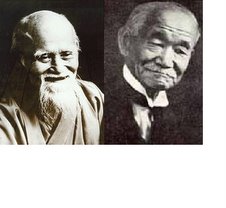Sunday, May 27, 2007
One more thing...
I forgot to add in the last post that me and Bryce also spent around 2 hours (after physical practice) talking about mai and it's relationship to everyone in Aikido and how it changes in Judo. Apparently there are 2 mai distances. There is the Aikido mai where your opponent would have to commit to stepping (or leaping) forward to get you, and there's a passive mai where someone gets about the distance and arm would be before it could hit your face, not your other arm. We played around how differently people react to those two instances. We did a little Judo randori and I've decided that every time I go back home now I'm going to take the video camera to Pat's with me, especially for me and Andy's randori sessions before class so when I get back home I can analyze what I need to work on a bit more objectively. Not so much point out "I should've done this here or that there", but more "Ok I'm leaning in when I'm closing mai, or my posture is horrible as I attempt hip throws". Any other suggestions on improving one's self when not in class (other than the standard repetition of tegatana would be most appreciated.
Subscribe to:
Post Comments (Atom)



2 comments:
I think you're a little off on this one. There is only one ma-ai. There can only be one maai because it is a safety margin. You're either inside or outside ma-ai distance.
If you start defining two ma-ai, then what you get is this fuzzy, indeterminate condition where you might be inside or outside, or maybe 'sorta' in maai. your subconscious starts having trouble getting you to evade as evil guy passes your safety distance.
In judo, almost all the action happens with the players clinched up inside ma-ai. Even though the spacing varies in the clinch, they are still both within each other's maai.
This is why striking is disallowed in judo randori. because we're working inside maai there's not as much that you can do about someone striking you. you can be hit before you can move.
Aikido, on the other hand usually makes the initial assumption that tori gets at least one step worth of warning so that his subconscious sense of maai comes into play to protect him. It's harder to do aiki starting inside maai - that's why its mostly delayed till sankata
Let me re-define then. I shouldn't call it Judo ma-ai, but I wanted to note the dead space after ma-ai but before an opponent can hit your head or torso, they can still strike your appendages, but not anything super-vital. I don't know if there is a word for that space, but I thought it was worth a mention since someone can passively move past ma-ai but as long as they don't cross that second space you can still effectively maneuver.
Post a Comment